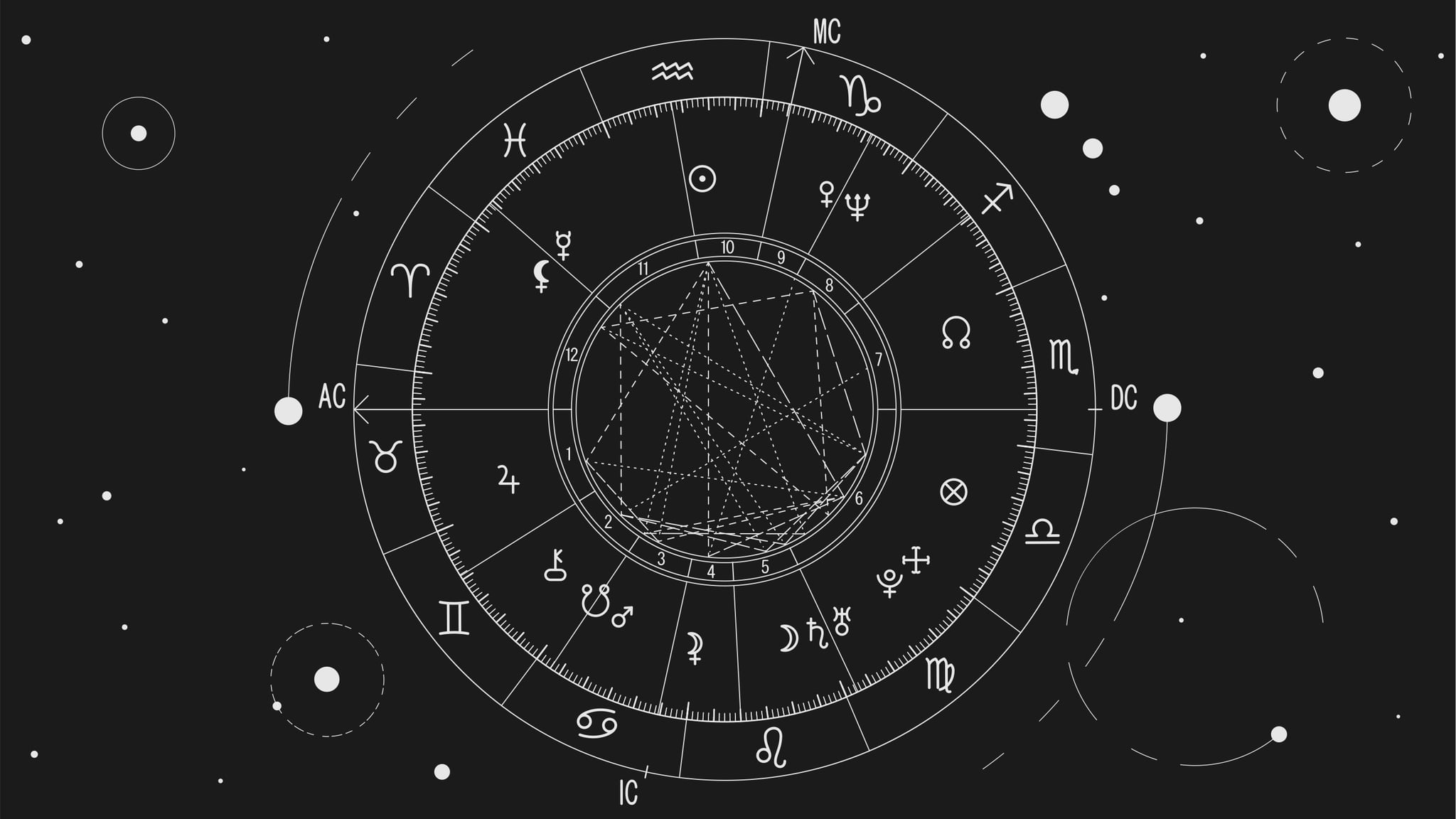Your Astrological Birth Chart, Explained

If you've ever been asked your birth time by a would-be romantic partner or astrology-loving bestie — something that's become increasingly common — chances are you've already heard at least bits and pieces about your birth, or natal, chart.
Maybe you know your "big three", aka your sun, moon, and rising signs, or have been presented with a circular chart covered in what looks like a different language. At the very least, you likely know your sun sign, the zodiac sign that the sun was in when you were born. While that's a key part of your overall personal astrological profile, it's simply one small puzzle piece in a much larger, multilayered picture. And that picture is your natal birth chart.
Here's what you need to know about natal charts (including where to find yours), as well as a breakdown of the eye-opening details you can pinpoint once you start exploring your unique astrological blueprint. Welcome to birth chart 101.
What Is a Birth Chart in Astrology?
Basically, your astrological birth chart is a snapshot of the sky — documenting where the planets, luminaries (the sun and moon), and other key celestial points and bodies were from your vantage point on Earth at the precise moment when you were born. The position of the planets and luminaries will be depicted in a circle chart, which represents the sky (though some apps or websites present it in a list format). All these different points combine to create an astrological profile that's uniquely you. (For example, check out how Harry Styles's birth chart totally makes sense for him, as does Doja Cat's.)
Say your birthday is Aug. 3. While the sun might have been in Leo, the moon, which moves pretty fast — it switches signs every two to two-and-a-half days — could have very well been in mutable water sign Pisces or cardinal air sign Libra. And the rising sign or ascendant, which is the sign that was rising (or ascending) on the eastern horizon at the time of your birth, shifts throughout the day, spending about two hours in a sign. Depending on what time you were born, you'll have a different rising sign from someone else with the same birthday.
And all of these "placements," as they're called in astrology, change from year to year. So while someone born on Aug. 3, 1993, at 1:30 a.m. in Chicago is a Leo with an Aquarius moon and Gemini rising, another Aug. 3 baby who came into the world in 1987 at 3:30 a.m. is a Leo with a Scorpio moon and Cancer rising. That said, while both people might have their sun in Leo, their other distinctive placements (in other words, each planet and sign combination) colour how they experience emotion (in terms of their moon sign) or come off to others when they're out in the world (the rising sign).
All of this is to say that your full birthdate, time, and birthplace are essential for calculating your highly unique birth chart.

Image Source: Getty Images / iStock
How to Calculate Your Natal Birth Chart
Once you have your birth date, time, and location ready, there are a few quick and easy ways to cast your natal chart:
- Google "free astrological birth chart," and you'll find lots of sites that offer software to do it. As an astrologer, I personally recommend CafeAstrology or Astro.com.
- Most personal astrologers offer natal chart readings, during which you'll not only get a copy of your chart but also a one-on-one consult that walks you through it.
The Building Blocks of a Natal Birth Chart
If you're just diving in and exploring your birth chart solo, here's some key info that will help you start to decode your personal astrology.
The Planets
Each planet, luminary, or key angle (the rising sign, for example, is one of four angles) in your chart represents a different aspect of your perspective and your personality's wiring. Here's a brief overview of the meaning of all the planets in your birth chart.
- Sun: Your core identity, self-image
- Moon: Your emotional compass, what brings you security, how you like to nurture and be nurtured
- Mercury: Your communication style, how you think, and how you listen
- Venus: How you relate, how you show affection, your sense of beauty
- Mars: Your energy, how you take action, your sex drive
- Jupiter: How you make your luck and experience abundance
- Saturn: How you face restriction, challenges, life lessons, and responsibilities
- Uranus: How you rebel and embrace what makes you different
- Neptune: How you imagine and dream
- Pluto: How you claim your power and experience transformation
- Rising Sign or Ascendant (ASC, the cusp of the first house): How others perceive you
- Medium Coeli or Midheaven (MC, the cusp of the 10th house): Your professional image and destiny
- Descendant (DC, the cusp of the seventh house): How you approach partnership
- Imum Coeli (IC, the cups of the fourth house): Your inner life
The 12 Zodiac Signs
Each of the above planets, luminaries, and points will fall into one of the 12 zodiac signs. And how the planet expresses itself in that sign offers intel on your personality. For instance, being born with Mars — the planet of action — in slow, steady earth sign Taurus means you're anything but fast-paced and impulsive when it comes to moving the ball forward on your goals.
What's more, each sign spans 0-30 degrees, so you'll note that your Venus, perhaps, falls at a particular number of degrees of a sign — for instance, 2 degrees Virgo. (Check out the section on Aspects below to understand how those degrees often come into play.)
It can also help to take a sign's ruling planet into consideration, as the terrain that the ruler oversees influences the sign's expression as well. For example, Taurus and Libra are both ruled by Venus and are therefore relationship oriented and drawn to artistic pursuits.
- Aries (ruled by Mars): Competitive, playful, action-oriented
- Taurus (ruled by Venus): Pragmatic, luxury-loving, sensual
- Gemini (ruled by Mercury): Curious, communicative, quick-witted
- Cancer (ruled by the moon): Nurturing, sentimental, security-seeking
- Leo (ruled by the sun): Charismatic, driven, optimistic
- Virgo (ruled by Mercury): Service-oriented, cerebral, sensitive
- Libra (ruled by Venus): Diplomatic, partnership-loving, social
- Scorpio (ruled by both Mars and Pluto): Private, powerful, intimacy-loving
- Sagittarius (ruled by Jupiter): Free-spirited, unfiltered, adventure-seeking
- Capricorn (ruled by Saturn): Hardworking, ambitious, traditional
- Aquarius (ruled by Uranus): Humanitarian, unconventional, future-minded
- Pisces (ruled by Neptune): Empathic, spiritual, imaginative
The Elements
The 12 zodiac signs are divided up into four elements: fire, earth, air, and water. Each one has its own expression and indicates various qualities. For example, water signs tend to be the most intuitive and emotional of the zodiac, while fire signs are go-getters. Earth signs are generally pragmatic planners, and air signs tend to be cerebral and social. There are three signs per element. Here's how those break down:
- Fire: Aries, Leo, Sagittarius
- Earth: Taurus, Virgo, Capricorn
- Air: Gemini, Libra, Aquarius
- Water: Cancer, Scorpio, Pisces
The Qualities or Modalities
Now you know there are three signs per element. Each sign is also assigned a quality or modality: cardinal, fixed, or mutable. There are four zodiac signs per modality. The cardinal signs are the initiators of the zodiac who may struggle with follow-through; they kick off a given season. The fixed signs are the most resolute (and also most stubborn) of the zodiac and fall at the heart of a season. And the mutable signs are the most adaptable — but also wishy-washy — signs, and they transition us from one season to the next. Here's how those look:
- Cardinal: Aries (beginning of spring), Cancer (beginning of summer), Libra (beginning of fall), Capricorn (beginning of winter)
- Fixed: Taurus (midspring), Leo (midsummer), Scorpio (midfall), Aquarius (midwinter)
- Mutable: Gemini (end of spring), Virgo (end of summer), Sagittarius (end of fall), Pisces (end of winter)
The Aspects
Once you've noted the signs that each of your placements fall in and are familiar with the signs' elements and qualities/modalities, you can better understand how your various natal chart placements relate to one another, which offers a complex but important layer of intel. Here are the most common, significant aspects to know about:
Conjunct: If you have placements that are in the same sign, they are considered conjunct and work in tandem, which can be quite powerful. In general, a Venus-Mercury conjunction, for example, will make for someone who's as charming as they are adept at self-expression.
Trine: If you have placements that are in the same element — say, your moon is in Cancer and Mars is in Scorpio — they form a harmonious angle in which they're able to help one another's function.
Square or Opposition: If placements are the same modality, they'll either be square or opposite one another. Signs that are three signs apart are square, while signs that are six signs apart are in opposition. For example, if you have your Mercury in Gemini and rising in Virgo — two mutable signs — they square one another. If your Mercury is in Capricorn but your rising is in Cancer, that's an opposition. Placements that square one another create tension that can be irritating or activating. Placements that oppose one another can be at odds with one another, but if you can work with an opposition's "two sides of the same coin" energy, you can find balance and growth.
Sextile: Fire and air are classically compatible, as are earth and water. If you have placements that correlate in this way and are within 3 degrees of one another, they're considered sextile — a friendly aspect that's not as apparent as a trine but shows cooperation between two placements. Say your Venus (charm, beauty, relationships) sextiles Pluto (power). You're definitely the type to be in love with love and to magnetize people on a subconscious level.
Note that no matter which of these aspects you're looking at, the closer your placements are to one another (in so far as the degrees they fall at within a given sign), the stronger and more notable the aspect will be. If they're in the same sign but more than 10 degrees apart, it's probably not an especially noteworthy aspect in your chart.
The Houses
Every natal chart is also divided up into 12 pie slices or houses, each representing a particular area of life. Where your placements "live" — aka the house they fall into — is yet another layer you'll want to take into consideration while interpreting your chart.
Each has their own traditional ruling sign, the archetype of which you can also look to as a way to characterize the house. These are the 12 astrological houses:
- First House of Self: ruled by Aries
- Second House of Income: ruled by Taurus
- Third House of Communication: ruled by Gemini
- Fourth House of Home Life: ruled by Cancer
- Fifth House of Romance and Self-Expression: ruled by Leo
- Sixth House of Daily Routine and Wellness: ruled by Virgo
- Seventh House of Partnership: ruled by Libra
- Eighth House of Emotional Bonds, Sex, and Joint Resources: ruled by Scorpio
- Ninth House of Adventure and Higher Learning: ruled by Sagittarius
- 10th House of Career and Public Image: ruled by Capricorn
- 11th House of Networking, Long-Term Wishes, and Friendship: ruled by Aquarius
- 12th House of Spirituality: ruled by Pisces
Traditional rulers are different from the signs that actually rule the houses in your chart. Think of the traditional house rulers as the permanent, universal landlords of each house, while your house rulers are completely unique and based on your rising sign, which rules your first house, and the sign after that will rule your second house, and so forth and so on. (That said, if you happen to have been born with an Aries rising, then they'll actually match up.)
How to Read Your Natal Chart
If this feels like a lot to wrap your head around, that's because it really is — and therein lies the beauty of natal astrology. Pros spend decades unpacking and delineating (aka interpreting) all of these layers for themselves and for others. And then, you can bring predictive techniques into the mix by comparing the natal chart to the current aspects in the sky and figuring out if someone is perhaps going through their Saturn return (a transit that occurs every 29-30 years and involves learning tough lessons and laying groundwork that'll serve you for decades to come) or if sleepy Neptune is opposed their Mars, and that's why they're feeling a little bit sluggish.
That said, although it can be challenging to figure out what it all means by yourself, there are plenty of tools online (such as websites like CafeAstrology and astrology apps like TimePassages) that will also help you understand all the details.
In short, thoroughly understanding your natal chart is far from something you can learn in an hour, an afternoon, or even after years of study. But by diving into self-study or working with a professional astrologer, you're sure to bolster self-awareness, enjoy personal growth, and become more fluent in the complex but incredibly useful language of the stars.









